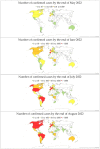Monkeypox: A Comprehensive Review
- PMID: 36298710
- PMCID: PMC9612348
- DOI: 10.3390/v14102155
Monkeypox: A Comprehensive Review
Abstract
The 2022 multi-country monkeypox outbreak in humans has brought new public health adversity on top of the ongoing coronavirus disease 2019 (COVID-19) pandemic. The disease has spread to 104 countries throughout six continents of the world, with the highest burden in North America and Europe. The etiologic agent, monkeypox virus (MPXV), has been known since 1959 after isolation from infected monkeys, and virulence among humans has been reported since the 1970s, mainly in endemic countries in West and Central Africa. However, the disease has re-emerged in 2022 at an unprecedented pace, with particular concern on its human-to-human transmissibility and community spread in non-endemic regions. As a mitigation effort, healthcare workers, public health policymakers, and the general public worldwide need to be well-informed on this relatively neglected viral disease. Here, we provide a comprehensive and up-to-date overview of monkeypox, including the following aspects: epidemiology, etiology, pathogenesis, clinical features, diagnosis, and management. In addition, the current review discusses the preventive and control measures, the latest vaccine developments, and the future research areas in this re-emerging viral disease that was declared as a public health emergency of international concern.
Keywords: emergency; emerging viral infectious diseases; epidemic; international concern; prevention; public health; vaccination; zoonosis.
Conflict of interest statement
The authors declare no conflict of interest.
Figures






References
-
- WHO | World Health Organization Multi-Country Monkeypox Outbreak in Non-Endemic Countries. [(accessed on 30 May 2022)]. Available online: https://www.who.int/emergencies/disease-outbreak-news/item/2022-DON385.
-
- Centers for Disease Control and Prevention (CDC) 2022 Monkeypox Outbreak Global Map. [(accessed on 10 September 2022)]; Available online: https://www.cdc.gov/poxvirus/monkeypox/response/2022/world-map.html.
-
- WHO | World Health Organization WHO Director-General’s Statement at the Press Conference Following IHR Emergency Committee Regarding the Multi-Country Outbreak of Monkeypox, 23 July 2022. [(accessed on 25 July 2022)]. Available online: https://www.who.int/director-general/speeches/detail/who-director-genera....
-
- Magnus P.v., Andersen E.K., Petersen K.B., Birch-Andersen A. A pox-like disease in cynomolgus monkeys. Pathol. Microbiol. Scand. 1959;46:156–176. doi: 10.1111/j.1699-0463.1959.tb00328.x. - DOI
Publication types
MeSH terms
Substances
LinkOut - more resources
Full Text Sources
Medical
Research Materials

